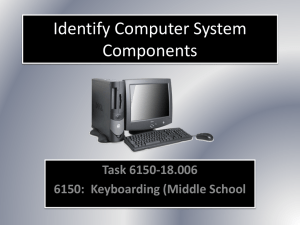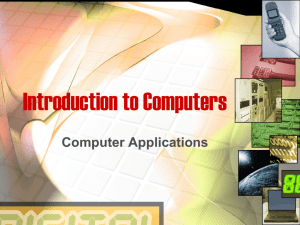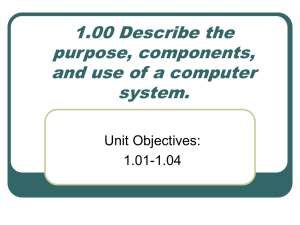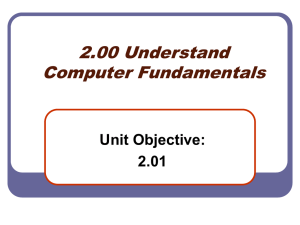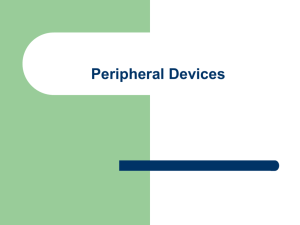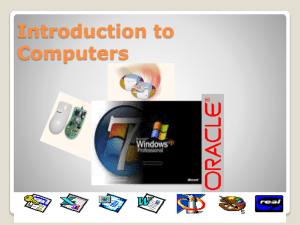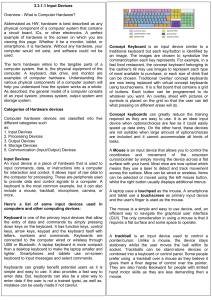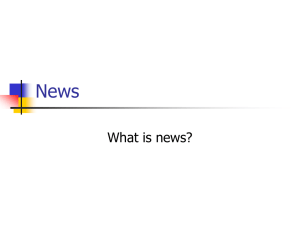PowerPoint Presentation - Computer Basics for Kids
advertisement
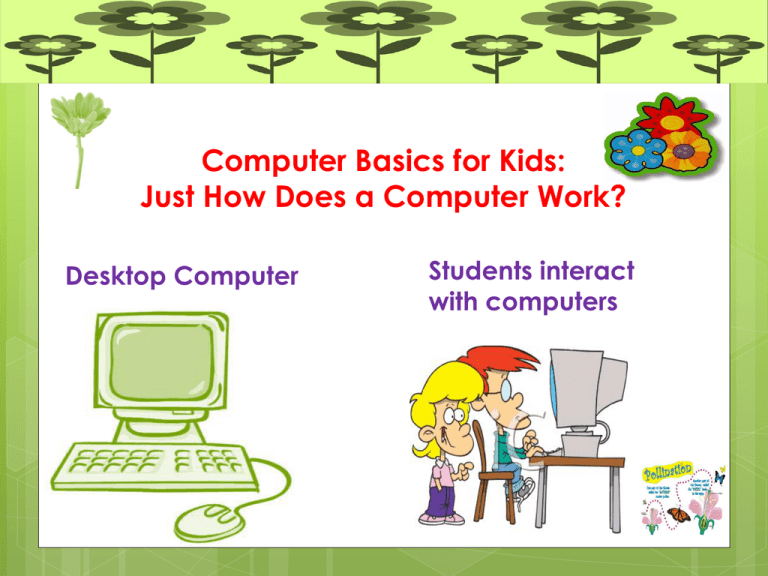
Computer Basics for Kids: Just How Does a Computer Work? Desktop Computer Students interact with computers Look at this picture of a computer from our Computer Lab. A computer is made up of many parts. Let’s explore the parts to see if you know what they are called! The Monitor The monitor looks like a TV and lets lets you see your work and your files. The CPU CPU stands for “Central Processing Unit”. They contain the brains of the computer. They can be desktop models that the monitor sits on top of, or tower models that stand up tall. Floppy Disk Drive The CPU has places to insert disks. One kind of disk drive is a floppy disk drive. A floppy disk drive reads information from a very thin, floppy disk inside a hard plastic case. Floppy disks can hold up to 1.44 megabytes of information. CD-ROM Disk Drive CD-ROM stands for Compact Disk-Read Only Memory. They are flat, shiny disks that store information. Most new computers have CD-RW drives. CD-RW stands for Compact Disk-ReWrite. This type of disk allows you to write information to it, as well as read from it. Most can hold up to 700 megabytes of information. DVD Drive/Burner The newest computers come with the option of a DVD drive. A DVD (Digital Video Disc) looks just like a CD, but holds much more information! They can store 4.7 gigabytes of data! Flash Drive A Flash Drive is a relatively new storage device. It’s like a mini, portable hard drive! You plug it into the USB (Universal Serial Bus) port on the front of newer computers and you can save to it! How Do Computers Work? Input--This is when information is entered into a computer. Some common input devices include the keyboard, mouse and scanner. Output--This is the information that comes out of a computer after it has been processed. The information comes out on output devices such as a printer or computer monitor. Processing--This is when the information is handled by the computer’s brain, known as the CPU (Central Processing Unit). Input Devices The Keyboard The keyboard is probably the most used input device. It operates a lot like a typewriter, but has many additional keys that let it do special things a typewriter can’t. Special Keyboard Keys The flashing light on the computer screen is called the cursor. This cursor can be moved up and down or left and right by pressing the 4 keys that have arrows on them. These arrow keys are called cursor keys. Shift Key When this key is pressed at the same time you press a letter key, a capital letter appears on your screen. When it is held down when you press a key with a symbol and number, the top symbol appears on the computer screen. There are two shift keys on your keyboard. A laser mouse doesn’t have a roller ball. It uses a laser light that makes the pointer move. Laser mice don’t have to have their insides cleaned! Scanner A scanner is a very useful input device. You can place a page of writing or pictures in the scanner and it will send the information to your computer. There they can be changed, saved into a computer file, or printed. Printers One output device is a printer. Once a computer user has created something on the computer, such as a story, he can send it to the printer. The printer prints exactly what’s on the screen. Speakers Speakers can be connected to your computer so you can hear very realistic sound effects and wonderful music. Some computer monitors come with built in speakers. You would have to press a key 5 times a second non-stop for over 6 YEARS to reach 1 billion keystrokes. One billion keystrokes equals just 1 GB of memory! Think about that the next time you think a webpage is loading too slowly! Just the beginning….. We just touched on the very basics with this presentation! There is so much more to understanding computers. There are books that are thousands of pages long that explain how they work in great detail. But now maybe you understand them more than you did before and you’ll want to keep learning. Keep computing! Created by Group 3 Junli Kasper Mike Dorgan Scott Plotts TLS318 University of Arizona September, 14, 2015 References Kids Domain Resources: Computer Connections, Computers Inside & Out http://www.howstuffworks.com “Computer Basics”, Teacher Created Materials, pub.1996

